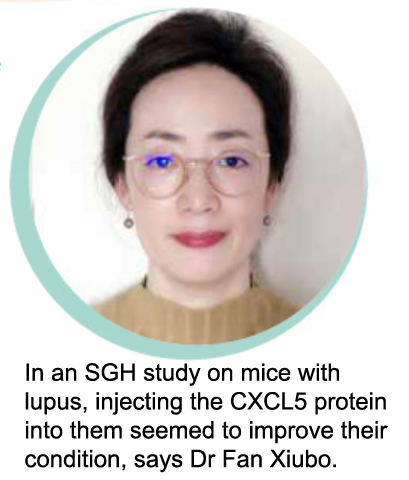Low levels of a protein in blood suggest reason for lupus activity and restoration to normal levels holds promise of treatment, SGH study finds.
A protein in blood may hold the key to treating systemic lupus erythematosus (SLE or lupus), an autoimmune disease that often causes a butterfly-shaped rash on the cheeks, a study by Singapore General Hospital (SGH) researchers has found.
The CXCL5 protein, which is naturally secreted in the human body, helps to regulate the immune system through neutrophils, a type of white blood cell. The immune system normally protects people against infections; however, in SLE patients, the immune system turns against itself and attacks the body’s healthy tissues and organs, causing widespread inflammation. “In SLE patients with active disease, we found that serum CXCL5 levels were significantly lower than in healthy individuals and were negatively correlated with disease activity,” said
Dr Annie Law, Senior Consultant, Department of Rheumatology and Immunology, Singapore General Hospital (SGH).
The study also found that restoring the level of the protein in mice improved survival. The team found that injecting mice with severe lupus weekly with CXCL5 restored balance, and improved survival from 25 per cent to over 70 per cent at 10 weeks. This number cannot be extrapolated to humans.
Furthermore, when CXCL5 was given together with cyclophosphamide (a conventional potent immunosuppressive treatment for lupus), CXCL5 seemed to prevent the toxic effects of cyclophosphamide, enabling the mice to survive up to two years. CXCL5 can be administered directly into the bloodstream via a vein or under the skin.

“Our study has shown CXCL5 to be safe. There was no liver or kidney toxicity, or cancer-inducing effects. Major components of the immune system were also not compromised. We hope to take our findings further to improve the care of patients with lupus,” said Dr Fan Xiubo, Principal Investigator and Senior Research Fellow, Department of Clinical Translational Research, SGH.
The team hopes to use the treatment in patients with moderate lupus, including those with lupus nephritis, where the kidneys are damaged by lupus.
The prevalence of lupus worldwide ranges from 37 to 100 per 100,000, compared to 40 to 150 per 100,000 in Asians, Dr Law said. The disease tends to affect Asians more severely. Both men and women can get the illness, with more women of reproductive age diagnosed with lupus.
As lupus has no cure, steroids, antimalarial drugs and immunosuppressants are used to control the condition. However, 30 to 60 per cent of patients do not respond to the aggressive drug regimens, said study senior author,
Associate Professor Andrea Low, Senior Consultant and Head, Department of Rheumatology and Immunology, SGH. The US’ Food and Drug Administration has approved just three new lupus drugs — with modest efficacy — in the past 65 years. “There is therefore a real and urgent need for better therapies, particularly for the more severe spectrum of lupus that we see in Asia,” said Assoc Prof Low.
Professor William Hwang, Senior Consultant, Department of Haematology, SGH, who co-led the early phases of the study, added, “It is gratifying to see that this research, which started over eight years ago, has led to a discovery that has the potential to offer patients with lupus new treatment options in future.” Prof Hwang is also Chief Executive Officer of the National Cancer Centre Singapore.
The study findings were published in October 2022 in one of the top peerreviewed rheumatology journals, Arthritis and Rheumatology, and were highlighted as an important study in Nature Reviews Rheumatology in November 2022. Patent covering these results was filed by SingHealth, and has since been granted in the US and Singapore.

The research team expects to enter Phase I and Phase II clinical trials in the next three years.
